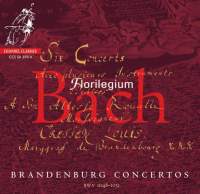Texte paru dans: / Appeared in: |
|
|
Outil de traduction (Très approximatif) |
|
|
Reviewer: Colin
Anderson I got to know the Brandenburg Concertos through Raymond Leppard's English Chamber Orchestra recordings. I loved the music Baroque at its best ‑ and thought the performances ideal. Fromn there I went to versions such as those conducted by Boult, Britten, Karajan and Klemperer; but there is room in my heart for a more 'authentic' reading, and this one from Florilegiurn does the job nicely. Of course, we can choose what to listen to from the 'six', or even any one movement from within any of the concertos. These CDs are laid out in reverse order, from No. 6 to No. 1, with Nos. 4‑6 on the first disc.
Thus (and to my surprise) I found myself starting with No. 6, which is given a measured, bouncy and full (if period) tone in the outer movements, the blissful central one very spacious, though maybe a little stiff. Does the recording present the musicians rather too closely, I wondered, thus conspiring against light and shade and dynamic variance, It's all a bit insistent, somewhat square, too, but there's a good spirit, hard‑working, well prepared and dedicated. Working backwards, No. 5 opens energetically, the solo violin and flute very much in the listener's ears, as is the harpsichord of Terence Charlston (all the instrumentalists are named in the booklet), who cuts loose in the lengthy and flamboyant first‑movement cadenza. Every musician here plays just as superbly.
However, the recording, as transferred, is too loud (an overly common as well as regrettable problem these days), remorselessly so making listening a chore; turn the sound down and the image narrows. This is a pity for there are joyous dance rhythms and elegant slow movements to savour, from musicians who really know their way through these timeless works, and the immediacy and clearness of sound is in itself considerately judged.
Nos. 4 and 3 are festive in character, the two movements of the latter linked by the shortest of violin flourishes. No. 2 enjoys some marvellous solo contributions, not least fronm Richard Fomison on trumpet, who is unfazed by the high‑lying challenges in the outer movements. The opening of No. 1 is a little confused, main lines covered by ornate horns, although the measured tempo is, once again, a pleasant revelation (within context) for this, the grandest of the set, and the interpreters craft much out of the shadowy slow movement, and then make merry with the third one. If the 'old guy' conductors tended to go slow with the Minuet sections of the finale, making them elephantine, the members of Florilegium find swift springiness, to advantage.
So, in
terms of the music: genius level; in terms of the performances: generally
persuasive and superbly played; in terms of the recorded sound: well judged,
although a little more space around the instruments would have been welcome;
in terms of post-production: well, here may be the problem, for my ears
(admittedly with headphones, but that is my usual method, for concentration
and clarity) had hoisted the white flag some time before the listening
session was over. I am not sure that Johann Sebastian Bach wanted his music
to shout.
|
|
|
|
|
|
Cliquez l'un ou l'autre
bouton pour découvrir bien d'autres critiques de CD |
|




